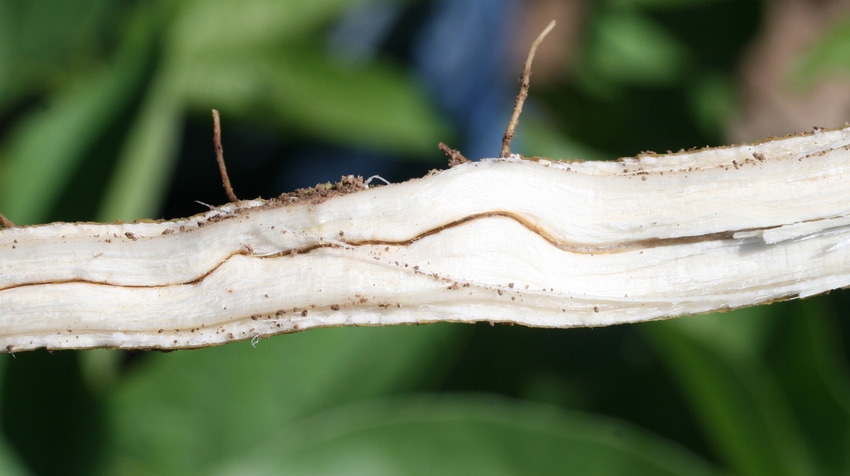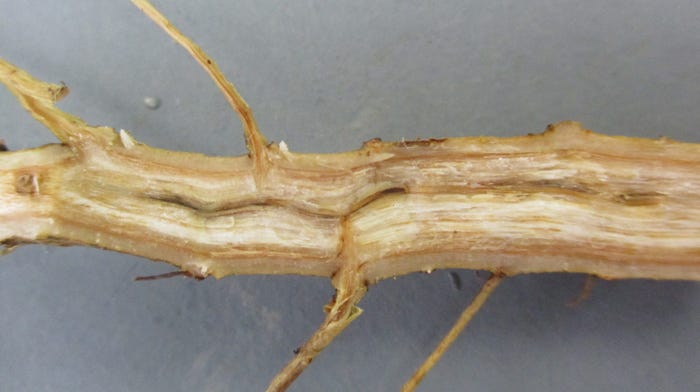
While Fusarium wilt, Fusarium oxysporum f. sp. vasinfectum Race 4, known as FOV4, is confined to the far west corner of Texas in El Paso and Hudspeth counties, where only .06 percent of Texas cotton is produced, a Texas A&M plant pathologist says there are concerns of the seedborne disease migrating from El Paso and other infested areas to regions like the Texas High Plains, where an average of 3.7 million acres is planted each year.
“We don’t know how this disease came to far West Texas,” says Dr. Tom Isakeit, professor and Extension specialist, field crops, Department of Plant Pathology and Micobiology. “What we do know is it can move in seed or on implements, such as module builders, that carry soil or seed from infested fields. Seed or implement movement between the El Paso area and other infested areas, such as the San Joaquin Valley of California, to other regions of Texas or other states, could serve as an entryway for this pathogen.
“And once this fungus is introduced to a field, it’s there forever.”

Other routes of introduction include gin trash from infested fields along with manure from cattle fed gin trash or cottonseed from FOV4 fields.
“The strongest recommendation to growers in the El Paso area is to keep the pathogen from spreading to other, non-infested fields within that area,” Isakeit says. But to those outside of far West Texas, he says, “We strongly warn people not to get any seed from the El Paso area for planting or cattle feed. Also, prior to moving implements, such as cultivators, they should be pressure washed with detergent to clean off any soil. Module builders should be thoroughly cleaned, as well.
“Growers considering planting commercial Pima seed should ask where the seed was grown and whether it is susceptible to FOV4. As a seed source, California’s San Joaquin Valley is a high-risk area.”
Additional caution should be taken with seed produced in foreign countries. “FOV4 is present in China and India. Currently, there is no good procedure for testing seed, so the most cautious approach is to plant seed produced in areas where FOV4 does not occur,” says Isakeit.
FOV4 was originally identified in 2003 in one county in the San Joaquin Valley but has since become widespread across that area, causing significant yield loss in susceptible Pima and upland varieties, he adds. “The introduction of FOV4 to major production areas of Texas, such as the High Plains, would not only limit the choice of varieties that could be grown but could also be devastating for seed production in these areas.”
FAMILIAR FUNGUS
While Fusarium wilt is no stranger to cotton, what separates FOV4 from the other pathogen races is it does not require root-knot nematodes to increase disease severity. “It’s a very aggressive pathogen,” Isakeit says. “It can also thrive in neutral to alkaline soils, whereas the other races tend to be more confined to acidic soils.”
FOV4 can cause seedling death, as well as leaf death and plant wilting later in the season. Susceptible Pima varieties tend to show more pronounced symptoms than susceptible upland varieties, says Isakeit. “A key diagnostic feature of FOV4 is seen by splitting roots lengthwise. Susceptible, infected plants will show a black streak in the center, or even a more pronounced root rot. Other races, and the Verticillium wilt fungus, produce vascular discoloration in the stem but not in the roots.”
As for control, Isakeit says there are tolerant varieties growers can plant. Many growers in the El Paso region have switched to resistant Pima varieties. “Work is on-going to evaluate susceptibility of upland varieties. Other management techniques such as crop rotation, fallowing and chemical treatments are not effective nor economical when it comes to treating FOV4.”
For more information, contact Isakeit or go to https://cochran.agrilife.org/files/2019/04/FOV-4-Bulletin-Cotton-Inc.pdf.
An interview with Dr. Isakeit on this subject is below. (Click on the fullscreen button in the bottom right-hand corner to get the full image.)
About the Author(s)
You May Also Like






